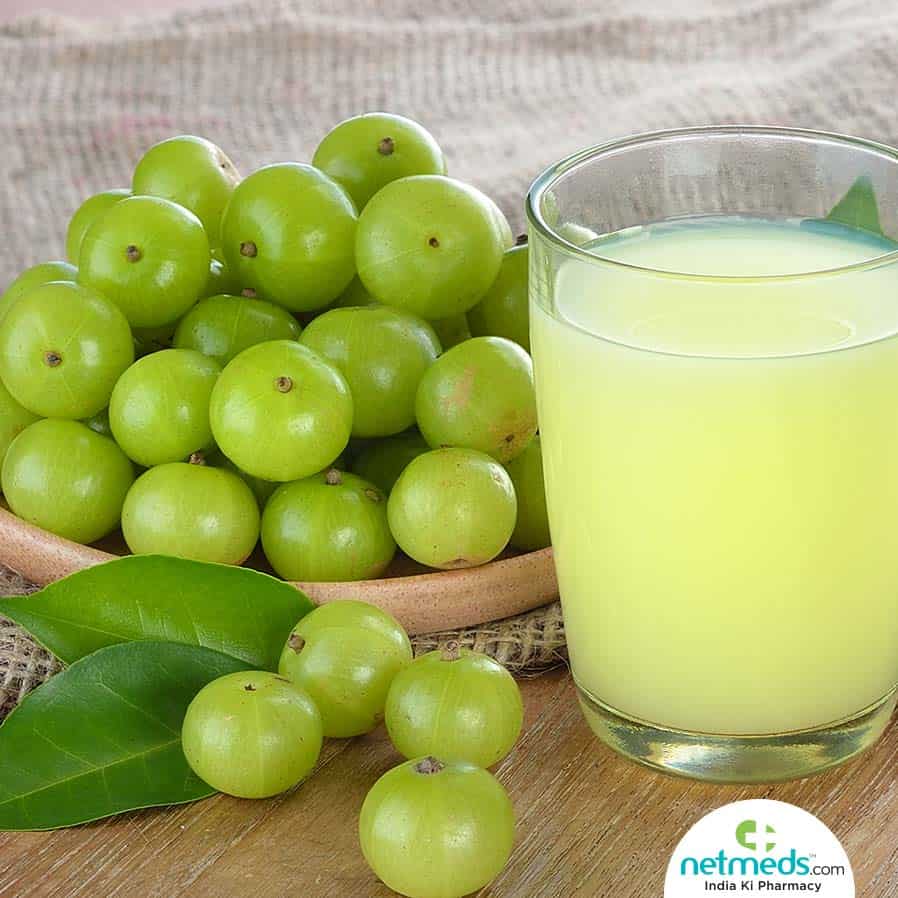Amla, Amalaki, or Indian Gooseberry is a highly used medicinal plant for its innumerable healing benefits. Amalaki, is popularly known in Sanskrit. In ancient texts of Ayurveda, it has various meanings – mother, nurse, immortality and it also means ‘sour’ which describes its taste.
This green, pulpy, juicy fruit also has its botanical names, ie., Emblica Officinalis or Phyllanthus Emblica. It is strongly recommended eating a gooseberry daily for improving immunity, boosting metabolism, and longevity.
Amla is also known to be a divine medicine with different tastes – sweet, sour, bitter, astringent, and pungent that help in the functioning of both mind and body.
Amla holds great religious importance during various rituals in the Hindu month of Kartik, which usually falls between October and November. People use it to treat various respiratory infections like the common cold, flu, and other health problems that are caused due to the imbalances of Vata, Kapha, and pitta.
Amla Juice and its oil have various advantages for digestive, hair, and skin health. It helps the overall health of an individual.
Amla’s Nutritional Facts-
The following nutritional information is provided by the USDA for 1 cup (150g) of raw gooseberries.
- Calories: 66
- Fat: 0.9g
- Sodium: 1.5mg
- Carbohydrates: 15g
- Fiber: 6.5g
- Sugars: n/a
- Protein: 1.3g
- Vitamin C: 46% of the Daily Value (DV)
- And Vitamin B5: 9% of the DV
- And Vitamin B6: 7% of the DV
- Copper: 12% of the DV
- Manganese: 9% of the DV
- Potassium: 6% of the DV
Nutritional Importance of Amla
One of the most notable nutrients in amla is vitamin C. Amla is an excellent source of vitamin C, with just one medium-sized fruit providing approximately 700% of the recommended daily value. Vitamin C is a water-soluble vitamin that is important for a variety of functions in the body, including the support of the immune system, the formation of collagen, and the absorption of iron.
In addition to vitamin C, amla is also a good source of other nutrients. It contains small amounts of dietary fiber, vitamin A, vitamin E, and several B vitamins. Amla also contains a range of antioxidants, including flavonoids and tannins, which may have potential health benefits.
Amla is also low in calories and has a low glycemic index, making it a good choice for people looking to maintain healthy weight and blood sugar levels. It is also a good source of natural hydration, as it is high in water content.
While amla can be a nutritious addition to a balanced diet, it is important to remember that it is not a magic bullet and should be consumed as part of a varied diet that includes a variety of nutrient-dense foods. It is also important to speak with a healthcare provider before adding amla or any other supplement to your diet, as it may interact with certain medications or have potential side effects.
In conclusion, amla is a nutritious fruit that is high in vitamin C and other nutrients, and it can contribute to a healthy diet when consumed as part of a balanced and varied diet. Its low calorie and glycemic index may also make it a good choice for people looking to maintain healthy weight and blood sugar levels.
Glycemic Index Of Amla
Amla, also known as Indian gooseberry, is a popular fruit in Ayurvedic medicine and is known for its high vitamin C content and potential health benefits. One aspect of amla that may be of interest to some people is its glycemic index (GI), which is a measure of how quickly a food raises blood sugar levels. In this blog, we will explore the glycemic index of amla and what this means for its potential impact on blood sugar control.
First, it’s important to understand what the glycemic index is and how it is determined. The glycemic index is a ranking of foods based on how quickly they raise blood sugar levels. Foods with a high GI are rapidly absorbed and cause a rapid and large increase in blood sugar, while those with a low GI are absorbed more slowly and cause a slower and smaller increase in blood sugar. The GI is measured on a scale from 0 to 100, with higher values indicating a faster and larger increase in blood sugar.
So, what is the glycemic index of amla? According to the International Tables of Glycemic Index and Glycemic Load, amla has a GI of approximately 20. This is considered a low GI, which means that amla is absorbed slowly and causes a slower and smaller increase in blood sugar. In comparison, foods with a GI of 70 or higher are considered high, and those with a GI of 56 to 69 are considered medium.
It’s important to note that the glycemic index of a food is only one factor to consider when it comes to its potential impact on blood sugar control. Other factors, such as the number of carbohydrates in a serving of the food and how it is prepared, can also affect blood sugar levels. Additionally, the glycemic index may not always accurately reflect the impact of food on blood sugar in an individual, as factors such as the individual’s age, weight, and activity level can also affect blood sugar response.
Overall, amla has a low glycemic index and may be a good choice for people looking to maintain healthy blood sugar levels. However, it’s important to consider the glycemic index in the context of a balanced and varied diet, rather than relying on it as the sole factor in choosing foods. As with any food, it’s also important to eat amla in moderation and to speak with a healthcare provider if you have any concerns about its potential impact on your health.
Benefits of Amla
Amla, aka Indian Gooseberry, is one fruit that is loaded with health advantages in a really small package. It is packed with vitamin C & contains antioxidants, fiber, and minerals like calcium and phosphorus.
-
Highly nutritious
– Gooseberries are favorably nutritious fruit. They are low in calories and fat but rich in dietary fiber, copper, manganese, potassium, and vitamins C, B5, and B6.
-
High in fiber and low in calories
– Gooseberries are rich in fiber yet lower in calories. You can eat a decent portion of it without consuming too many calories. Eating amla may benefit in weight loss and reduced appetite.
-
Rich in antioxidants
– Gooseberries are plentiful in antioxidants, such as phytonutrients, and vitamins E and C, which may help protect your brain and fight aging, type 2 diabetes, cancer, and heart disease.
Build immunity
– The fruit is a rich source of Vitamin C, Vitamin B Complex, and antioxidants. These nutrients not only flush unhealthy toxins from the body. But also help in fighting dangerous free radicals. The presence of anti-inflammatory compounds in amla help in reducing the levels of inflammation in the body. Thus, preventing infections. It also contains immune-boosting properties. It is a winter fruit to snack on and fights off infections.
-
Protect your brain and heart health
– Gooseberries are rich in citric acid, phenols, and antioxidants which decrease the risk of age-related brain diseases, such as Alzheimer’s and stroke. This is packed with Vitamin C and fiber and is quite effective in reducing bad cholesterol and keeping your blood pressure under control. Furthermore, enhancing your heart health and longevity.
-
Control blood sugar levels
– Amla is useful for diabetes. Amla is highly nutritious and is low in the glycemic index, which makes it a nutritious fruit for people with diabetes. It helps to maintain the blood glucose level, acting as a simple but effective home remedy for diabetics. Hence, it is advised that diabetics should include this nutrition-packed fruit in their diet for a healthy life.
-
Helps in weight loss
– High in protein and fiber, gooseberry has the ability to speed up body metabolism and aid in weight loss. Further. It keeps you satisfied and prevents unnecessary/unhealthy food cravings.
-
Improve digestion and Better bowel movements
– Amla is a rich source of fiber that helps in stimulating bowel movement. It acts as a great source of laxatives thereby helping people with constipation. Moreover, it also facilitates the secretion of gastric juices and thus, enhances digestion. The presence of a wide range of nutrients in amla makes it a significant natural remedy for constipation. To reap its advantages, you can have a small glass of freshly prepared amla juice early in the morning for smooth digestion. For people struggling with constipation, add around one teaspoon of amla powder to a glass of lukewarm water and drink it at night for effective results.
- Promote hair growth and skin health- Gooseberry is packed with hair-friendly nutrients like calcium, Vitamin A, iron, and antioxidants. It slows down greying hair, prevents dandruff, strengthens hair follicles, and increases blood circulation to the scalp. Gooseberry is extremely beneficial for your skin as well. Drinking a glass of gooseberry juice every morning can help you with glowing skin.
- Acid reflux– People bearing GERD and acid reflux can also benefit from amla powder. Consuming one gram of gooseberry twice every day can also lessen the severity and frequency of heartburn and reflux after four weeks, compared with a placebo.
Benefits of Amla Juice-
-
Powerful Home Remedy
– Amla juice helps to treat problems like cough and flu as well as mouth ulcers. Two teaspoons of amla juice with equal portions of honey, if consumed every day can help a great value in treating colds and coughs. Mix a couple of teaspoons in water and gargle with it twice a day to get rid of ulcers.
-
Lowering Cholesterol Levels-
Regular intake of amla juice helps in lowering cholesterol levels. Amino acids and antioxidants help in the overall functioning of the heart.
-
Helps in managing diabetes-
This magical citrus fruit juice is also beneficial in managing diabetes, and respiratory ailments like asthma.
-
Supports Liver- Drinking amla juice daily can help in better liver function and flushes out toxins from the body.
-
Skin health- According to reports, if you dab a cotton swab of amla juice onto your face it can fight marks, pigmentation, and blemishes.
-
Weight Loss- It cuts down the extra body fat and cleans your stomach properly.
-
Amla juice for Hair growth- Amino acids and protein existing in amla juice benefits hair growth, deal with hair fall and revitalize the root as well as the shaft.
Benefits of Amla Juice on an Empty Stomach
Drinking amla juice on an empty stomach should be the first thing in the morning routine so that it ensures the absorption of all nutrients. It can work as an amazing energy booster at the start of the day or as a relaxing beverage. The juice will help your body digest and repair more powerfully while you sleep.
How to consume amla juice?
It is best to include amla juice first thing in the morning. A small portion is diluted in a glass of water. You can choose to incorporate a bit of lemon juice and honey to enhance the deliciousness. For those who are struggling with high cholesterol levels and hair issues, for them amla juice in combination with aloe vera juice does wonders. It also helps in better eyesight. Amla juice taken right before sleeping helps a great deal; it also aids in detoxifying the unhealthy effects of junk food.
What is the appropriate time to drink amla juice?
It depends on your purpose for consuming the amla juice.
- If you are taking it for normal fitness, anytime before your meal once a day.
- If you are consuming it for acidity drink it after 1/2hr of your meal.
- If you want it for washing the system then an empty stomach in the early morning is good.
- If you are treating the liver then thrice before 1/2 hr of your meal.
- For people with diabetes, it depends on your sugar level twice or thrice a day along with your meal. Fresh amla pieces work pleasingly for diabetic people.
- For kidneys it is better to combine along with drinking water and drink it in smaller doses throughout the day, it is better to do with your doctor’s advice. It depends on the severity of the kidney damage.
- For kids, you can provide amla juice along with honey or sugar.
Benefits of Amla Powder-
- Immunity Booster- Amla powder is the purest form of Vitamin C and it enhances you from within by making the blood vessels stronger and stouter. It also improves your immunity so that you can resist infections easily.
- Reduces risk of heart disease– One of the best amla powders advantages is that it lowers the risk of heart disease by controlling the build-up of bad cholesterol,
- Blood purifier-Amla powder when taken with a teaspoon of honey works as a great blood purifier. You can also combine it with jaggery and drink it. Regular consumption of amla powder helps in raising your hemoglobin naturally.
How to use Amla Powder?
Consumption of Amla Powder in a day-
- As a nutrition supplement– Amla Powder, when used as a healthy supplement, should be consumed half to one teaspoon twice a day, preferably with lukewarm water after the meal. You can also use it for external usage if you want.
- For Application on the face – Amla powder can be blended with raw honey to moisturize the skin and treat acne.
-To brighten the skin, it can be combined well with papaya and honey.
-The combination of rose water and amla powder can be used as a toner.
-The mixture of amla powder, honey, and yogurt gives an instant glow to the skin.
- For Application on Hair-
-
- You can mix it with henna to utilize it as a hair dye for a cooler tone. It also nourishes hair and makes them shine.
- You can mix it with coconut oil and massage it thoroughly on the scalp, which aids in hair growth. For optimum results, Shikakai or egg can also be added to the mixture.
- You can also use it as a hair mask. 2 teaspoons of amla powder should be mixed with shikakai, 1 teaspoon of honey, and 2 teaspoons of yogurt in warm water. The paste should be applied and allowed to sit for 30 minutes before washing it off with warm water or egg for hair growth.
- To treat obesity and respiratory diseases: Half to one teaspoon of it with 1 tablespoon of honey should be consumed to treat obesity and respiratory diseases.
- And, To treat joint diseases and gas trouble: A paste of 1 teaspoon with 2 teaspoons of sesame oil, you can consume with lukewarm to treat and prevent joint diseases and gas trouble.
- To treat digestion or skin-related issues: You can have a concoction of 1 teaspoon amla powder and 1 teaspoon ghee (or jaggery) with lukewarm water to treat and prevent digestion or skin-related issues.
Precautions and Warnings
Following are the precautions that must be taken before and during the use of Amla Powder–
- In case the patient is allergic to amla, the use of it should be avoided.
- The use of this powder should be avoided by patients suffering from hyperacidity, ulcers, loose motions, hypoglycemia, and hypotension. It may result in negative effects or may aggravate the condition of the patient.
- People who have been consuming anti-diabetic medicine and Vitamin C supplements should avoid using them as it may result in hypoglycemia and vitamin C toxicity respectively.
- The patient should avoid over-consumption of Amla Powder as it may result in hyperacidity, mild abdominal discomfort, and unwanted weight loss.
Amla Powder Brands:
It is available under various brands. Some brands under which Amla Powder is available are:
- Khadi Naturals Ayurvedic Amla Powder
- Patanjali Divya Amla Churna
- Herb Essential Amla Powder
- Jain Amla Powder
- Aarshaveda Organic Amla Powder
- Ayur Amla Extract Powder
- Naturemed’s Amla Powder
How to Store Amla Powder?
It is suggested to store this powder in a cool and dry place. One must keep the powder out of the reach of children and pets. The packaging of this medicine must be kept intact in order to maintain its effect when being administered.
How to include amla in your everyday diet?
- Amla Juice – Consuming amla juice is the easiest way to benefit from this superfood.
- With aloe vera juice – You could even combine it with aloe vera juice. Pour a couple of teaspoons of amla juice into fresh fruit juices for flavor.
- Dried Amla– Drying amla is a good way to conserve it for later use. Chop and deseed amla into chunks, mix with a bit of salt and dry in the sun for a few days. Store in a cool, dry spot.
- Pickles: Sweet or otherwise, it still gives you all the advantages.
Amla on Keto Diet
Gooseberries are allowed to be consumed on the keto diet! Gooseberries contain about 0 grams of net carbohydrates per 3.5 ounces (100 grams), which makes it an effortless berry to fit into your keto diet plan. This is a keto-friendly fruit that is slightly difficult to consume raw. It is sour in taste. So you can half dry it in the sun with sprinkles of salt over it.
This berry is one of the many berries that will not equip you with good fats but eating it includes other amazing advantages!! Gooseberries are ideal blood purifiers and that’s why they’re used for pickles (fermented with salt and spices) by Indians. You can also prepare gooseberry candies, to ease digestion after every meal. Amla is recommended as one of the top fruit in the Paleo diet (Indian version of Keto)
To conclude, gooseberries are healthy, low-calorie fruits that are rich in vitamins, minerals, and antioxidants. Amla has various health advantages. Gooseberries are completely beneficial to include in your diet as a snack or flavorful addition to meals.
FAQ’S
- What is another name for Amla?
Amla is also known as Indian Gooseberry.
- Are gooseberries low in calories?
Yes, gooseberries are low in calories. 1 cup of gooseberries contains just 66 calories.
- Can we have Amla on a keto diet?
It is a big yes! Amla is a keto-friendly fruit, low in carbs and you can incorporate them easily into your keto diet.
- What are the benefits of Amla?
They are low in calories, an amazing source of protein, vitamins, and minerals, and promote hair growth and skin health.
- How to include amla in your everyday diet?
You can make your own amla juice or you can add amla in pickles for long-term advantages. Use amla berries in chutneys and curries. Juice- mixed with bitter gourd and tomato.
Get started with your Weight Loss Journey today and take a step towards a healthy lifestyle! Stay tuned for inspiring Weight Loss Journeys, and Delicious Recipes! Also, don’t forget to follow us on Instagram for the daily dose of Health, and Wellness content!










